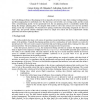Free Online Productivity Tools
i2Speak
i2Symbol
i2OCR
iTex2Img
iWeb2Print
iWeb2Shot
i2Type
iPdf2Split
iPdf2Merge
i2Bopomofo
i2Arabic
i2Style
i2Image
i2PDF
iLatex2Rtf
Sci2ools
138
click to vote
EOR
2007
2007
Airline crew scheduling from planning to operations
Crew scheduling problems at the planning level are typically solved in two steps: first, creating working patterns, and then assigning these to individual crew. The first step is solved with a set covering model, and the second with a set-partitioning model. At the operational level, the (re) planning period is considerably smaller than during the strategic planning phase. We integrate both models to solve time critical crew recovery problems arising on the day of operations. We describe how pairing construction and pairing assignment are done in a single step, and provide solution techniques based on simple tree search and more sophisticated column generation and shortest-path algorithms. 1 Background The airline industry has been a rich source of operations research problems, mainly due to the combinatorial nature of the problems. Typically the planning problem involves creating lines of work referred to as rosters for aircraft and crew. The crew rosters consist of activities that c...
Related Content
| Added | 13 Dec 2010 |
| Updated | 13 Dec 2010 |
| Type | Journal |
| Year | 2007 |
| Where | EOR |
| Authors | Claude P. Medard, Nidhi Sawhney |
Comments (0)

